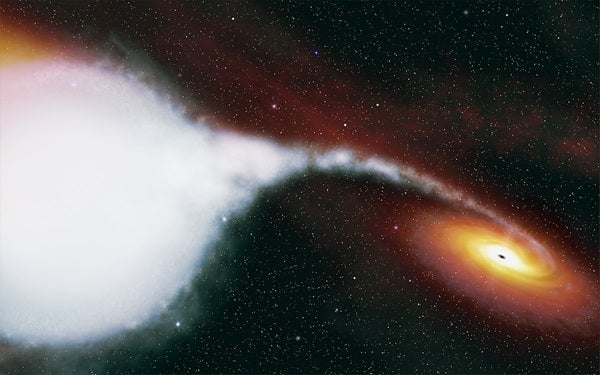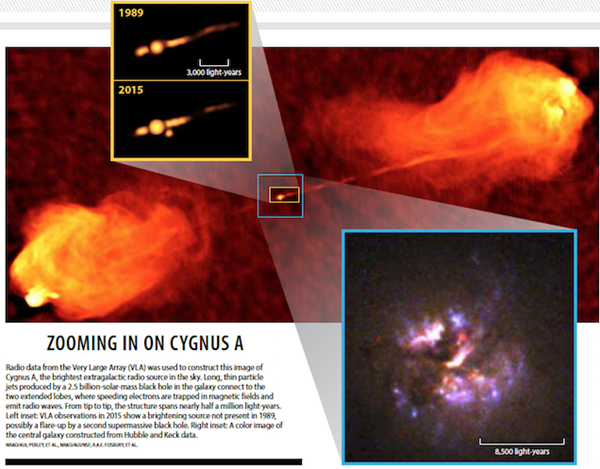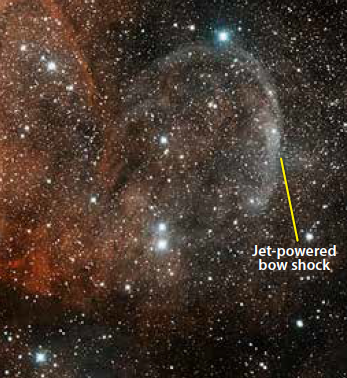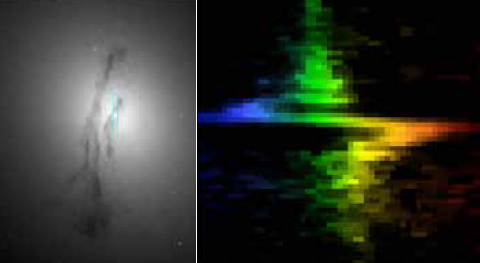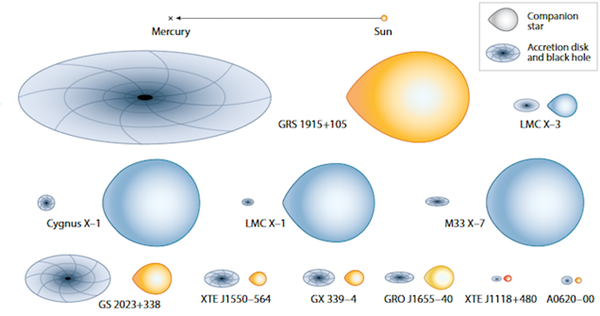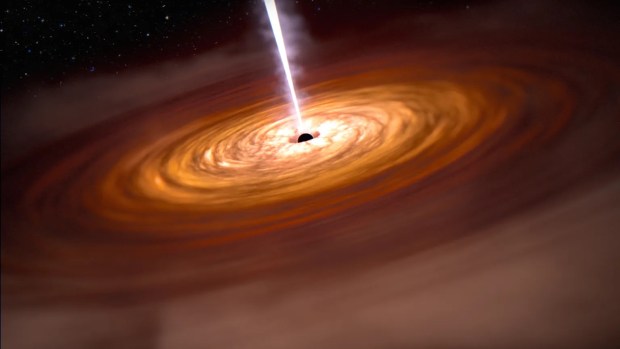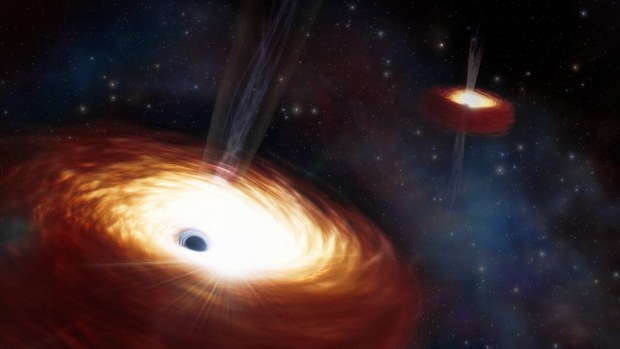Over the next few years, Reber extended his research of what he called “cosmic static,” eventually publishing sky maps showing prominent radio sources in the constellations Cassiopeia and Cygnus. The first, called Cassiopeia A, is the brightest extrasolar radio source in the sky, now known to be a young supernova remnant.
The other source, Cygnus A, is a galaxy more than 750 million light-years away. Reber had made the first observation of a black hole, one more than 2 billion times the mass of the Sun. Astronomers now think such enormous “supermassive” black holes reside in the centers of most big galaxies, including our own. Recently, observations of Cygnus A using the Very Large Array in New Mexico revealed another bright radio source — possibly another giant black hole — near the galaxy’s center.
Our growing understanding of black holes has unfolded along three distinct but related tracks: first through efforts to understand gravity itself, then explanations of how so-called active galaxies like Cygnus A could emit such vast amounts of energy, and finally the discovery of small stellar-mass black holes in our home galaxy and beyond.
Although the term black hole wasn’t coined until 1967, when American physicist John A. Wheeler first mentioned it in a talk, the quest for these enigmatic objects began much earlier.
In May 1783, the English scientist-turned-clergyman John Michell envisioned a star so large that its escape velocity equaled the speed of light. He wrote that “all light emitted from such a body would be made to return towards it, by its own proper gravity,” rendering the star invisible to astronomers. Although undetectable by its own light, he noted, the object could be found by observing irregularities in any “luminous bodies” that happened to revolve around it. Next, France’s Pierre-Simon Laplace independently postulated the existence of black holes in a book published in 1796.
Fast forward to late 1915, when Albert Einstein published the defining paper on his general theory of relativity. A few weeks later, fellow German physicist Karl Schwarzschild published an exact solution to Einstein’s new relativity equations, which revealed the radius that a given mass would need to be compressed to before collapsing into a black hole. This “Schwarzschild radius” marks the event horizon — the point of no return, from which nothing, not even light, can escape — for a non-rotating black hole. Half a century later, the New Zealand mathematician Roy Kerr described an exact solution for rotating versions of these gravitational beasts.
In 1934, astronomers Walter Baade and Fritz Zwicky suggested that supernova explosions represented the transformation of a normal star into a neutron star, an object with the Sun’s mass, but crushed into a sphere the size of Manhattan. A few years later, physicists J. Robert Oppenheimer and George Volkoff, using work by physicist Richard Tolman, showed that if neutron stars become too massive, they must continue to collapse.
The heaviest measured neutron star at the moment is the pulsar PSR J0348+0432, which tips the scales at 2.01 solar masses. We know now that when a massive star runs out of fuel and collapses under its own weight, the resulting supernova crushes the stellar core to extreme densities. If the mass of the core falls somewhere between 2.01 and 3 solar masses (exactly where depends on unknown details of neutron star structure), then a stellar-mass black hole is born.
Confirmed stellar-mass black holes exist in 20 or so X-ray-emitting binary systems found in our galaxy and its neighbors. In these systems, a normal companion star orbits close to the black hole. Observing the orbital motions of the companion allows astronomers to determine the masses of both members of the system. If the mass of the compact object exceeds three Suns, then it must be a black hole.
Most of these systems remain dormant for decades while gas streaming from the companion star slowly accumulates into a storage disk around the black hole. Eventually, the disk becomes unstable, and gas begins spiraling inward. Friction heats the gas up to millions of degrees so it glows in X-rays before plunging past the event horizon. Outbursts like this typically last about a year before the system returns to dormancy.
A few systems persistently produce X-rays, and the most famous and best studied is Cygnus X-1. Located about 6,100 light-years away, the binary system is made up of a 15-solar-mass black hole orbiting the common center of mass it shares with a hot, blue O-type supergiant, which is estimated at 25 or more solar masses. The star’s surface is so hot it continuously sheds plasma into space, creating a fast-moving outflow called a stellar wind. As the black hole orbits the star, it sweeps up a small part of this outflowing gas, which produces X-rays when the gas falls toward the black hole.
The closest confirmed black hole is A0620–00, about 2,800 light-years away, but it’s likely there are many others much closer that we haven’t yet found. Astronomers estimate that our Milky Way may hold as many as 100 million stellar-mass black holes. “That means, with high probability, there is a black hole within about 20 light-years of Earth — we just don’t know where,” says Jeremy Schnittman, an astrophysicist at NASA’s Goddard Space Flight Center in Greenbelt, Maryland. Unless black holes are “fed” with matter that emits light as it heats up on the way in, they can be hard to find.
Peering into the centers of other galaxies provides even more evidence. For example, in 1997, astronomers aligned the slit of Hubble’s Space Telescope Imaging Spectrograph (STIS) with the center of galaxy M84 in the Virgo cluster, revealing a dramatic swing in gas motions over a comparatively small distance. STIS measured a gas velocity of 880,000 mph (1.4 million km/h) within 26 light-years of the galaxy’s center. From this motion, astronomers calculated that the black hole at the heart of M84 contains at least a whopping 300 million solar masses.
Since 2015, striking new evidence for the existence of black holes has come from the Laser Interferometer Gravitational-wave Observatory (LIGO), which so far has detected nearly half a dozen merging black hole pairs. Large orbiting masses lose energy by creating ripples in space-time called gravitational waves, yet another prediction of Einstein’s relativity. And as they lose energy, binary black holes draw closer together over millions of years until they coalesce.
From stellar-mass black holes that pepper our galaxy to their monster brethren that drive jets spanning hundreds of thousands of light-years, there’s still much to learn about these mind-bending objects. But a mountain of astronomical evidence shows that black holes are here to stay.

